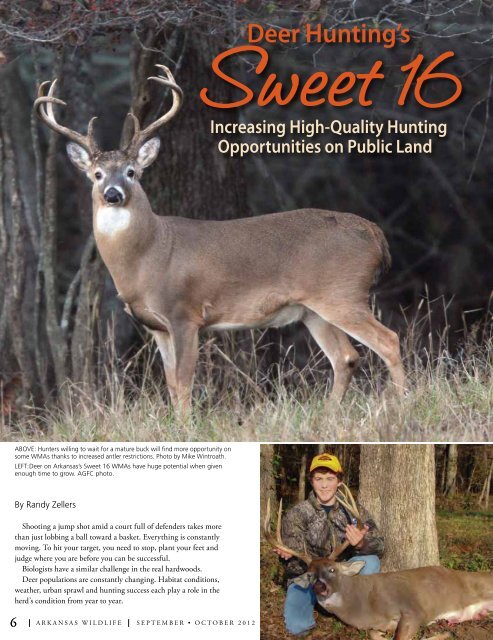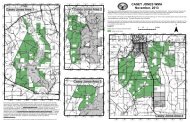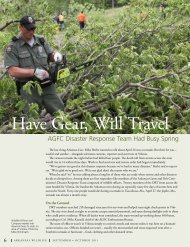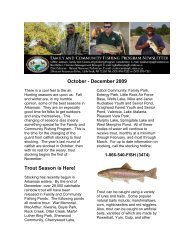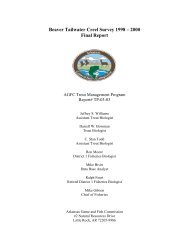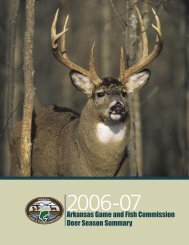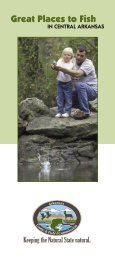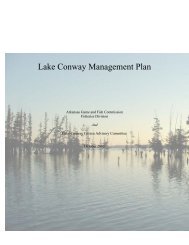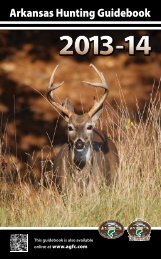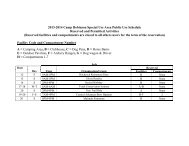Deer Hunting's Sweet 16 - Arkansas Game and Fish Commission
Deer Hunting's Sweet 16 - Arkansas Game and Fish Commission
Deer Hunting's Sweet 16 - Arkansas Game and Fish Commission
You also want an ePaper? Increase the reach of your titles
YUMPU automatically turns print PDFs into web optimized ePapers that Google loves.
ABOVE: Hunters willing to wait for a mature buck will find more opportunity on<br />
some WMAs thanks to increased antler restrictions. Photo by Mike Wintroath.<br />
LEFT:<strong>Deer</strong> on <strong>Arkansas</strong>’s <strong>Sweet</strong> <strong>16</strong> WMAs have huge potential when given<br />
enough time to grow. AGFC photo.<br />
By R<strong>and</strong>y Zellers<br />
Shooting a jump shot amid a court full of defenders takes more<br />
than just lobbing a ball toward a basket. Everything is constantly<br />
moving. To hit your target, you need to stop, plant your feet <strong>and</strong><br />
judge where you are before you can be successful.<br />
Biologists have a similar challenge in the real hardwoods.<br />
<strong>Deer</strong> populations are constantly changing. Habitat conditions,<br />
weather, urban sprawl <strong>and</strong> hunting success each play a role in the<br />
herd’s condition from year to year.<br />
6 ARKANSAS WILDLIFE SEPTEMBER • OCTOBER 2012
Yell<br />
<strong>Game</strong> Plan<br />
The AGFC’s deer team evaluates the agency’s strategic deer<br />
plan every few years to keep it on target. The last update to the<br />
plan was completed in 2007, <strong>and</strong> the next incarnation will be<br />
complete in 2013.<br />
Cory Gray, AGFC deer program coordinator, says the plan<br />
constantly evolves with the latest conditions <strong>and</strong> hunter attitudes.<br />
“We made some good improvements in management during<br />
the 2007 plan, including more public input,” Gray said. “But the<br />
on-the-ground work focused on private l<strong>and</strong> through the <strong>Deer</strong><br />
Management Assistance Program <strong>and</strong> our private l<strong>and</strong> biologists.<br />
It’s time to take the next step <strong>and</strong> include more detailed<br />
management on public l<strong>and</strong>.”<br />
After a thorough review of AGFC wildlife management<br />
areas, the deer team selected <strong>16</strong> to be showcases in advanced<br />
management <strong>and</strong> monitoring. The goal on these sweet <strong>16</strong> is<br />
increased opportunity for public l<strong>and</strong> hunters to harvest mature<br />
bucks normally found only on heavily controlled leases <strong>and</strong><br />
clubs.<br />
“We chose the WMAs based on their location <strong>and</strong> potential to<br />
offer high-quality deer,” Gray said. “Some were already known as<br />
big deer areas. We hope the rest will share that reputation soon.”<br />
Sevier<br />
Benton<br />
Washington<br />
Crawford<br />
Sebastian<br />
Polk<br />
Scott<br />
Little River<br />
Howard<br />
Franklin<br />
Miller<br />
Madison<br />
Logan<br />
Pike<br />
Carroll<br />
Region 7<br />
Montgomery<br />
Region 5<br />
12<br />
Hempstead<br />
3<br />
9<br />
8<br />
Johnson<br />
Newton<br />
Region 6<br />
Lafayette<br />
Nevada<br />
Boone<br />
Clark<br />
Pope<br />
Garl<strong>and</strong><br />
Columbia<br />
Perry<br />
4<br />
Hot Spring<br />
Ouachita<br />
Marion<br />
Searcy<br />
13<br />
Conway<br />
Saline<br />
Dallas<br />
Region 4<br />
Union<br />
Grant<br />
Calhoun<br />
Baxter<br />
Van Buren<br />
11<br />
Pulaski<br />
Stone<br />
Faulkner<br />
Clevel<strong>and</strong><br />
Bradley<br />
Izard<br />
Cleburne<br />
White<br />
Lonoke<br />
Jefferson<br />
Fulton<br />
Region 8<br />
Lincoln<br />
Drew<br />
Ashley<br />
Sharp<br />
Independence<br />
Prairie<br />
1<br />
6<br />
10<br />
Region 3<br />
7<br />
<strong>Arkansas</strong><br />
Jackson<br />
Woodruff<br />
14<br />
<strong>16</strong><br />
Desha<br />
Monroe<br />
Chicot<br />
R<strong>and</strong>olph<br />
Lawrence<br />
15<br />
5<br />
Cross<br />
Lee<br />
2<br />
Phillips<br />
Greene<br />
Craighead<br />
Region 1<br />
Poinsett<br />
St. Francis<br />
Clay<br />
Region 2<br />
Crittenden<br />
Mississippi<br />
In the Genes<br />
Increasing the quality of deer involves age, nutrition <strong>and</strong><br />
genetics. Brad Miller, assistant chief of the AGFC Wildlife<br />
Management Division says only two of these factors can be<br />
impacted on public l<strong>and</strong>.<br />
“We boost nutrition with proper habitat management <strong>and</strong><br />
available forage,” Miller said. “And we can impact the age at<br />
which bucks are harvested through regulations, but genetics is<br />
nearly impossible to change on free-ranging deer.”<br />
Miller explains that the genes to create superior antlers <strong>and</strong><br />
body size aren’t carried only in bucks.<br />
“The doe that produces the deer carries half of the genetic<br />
makeup as well,” Miller said. “And there’s no way to tell which<br />
doe is carrying those superior genes.”<br />
Miller also points out that you can’t control genetics when<br />
the deer are never allowed to grow to their potential.<br />
“White-tailed deer don’t reach their maximum potential until<br />
five-<strong>and</strong>-a-half years old,” said Miller. “The average age at which<br />
bucks are harvested on our WMAs is about two-<strong>and</strong>-a-half<br />
years old.”<br />
Aging Venison<br />
Through the <strong>Sweet</strong> <strong>16</strong>, biologists hope to increase the age<br />
of harvested bucks. Just as the three-point rule protected<br />
most fawns <strong>and</strong> yearling bucks from harvest, increased antler<br />
restrictions will promote more mature deer on these WMAS.<br />
“We want to move more deer into that three-<strong>and</strong>-a-half year<br />
old age class,” Gray said. “To do that, we need to change the<br />
way hunters measure deer in the field.<br />
“There are three main ways to judge age by antlers,” Gray<br />
said. “Counting points is the easiest way, but the least accurate.<br />
1 Bayou Meto WMA<br />
2 Dave Donaldson Black River WMA<br />
3 Dr. Lester Sitzes III Bois D’Arc WMA<br />
4 Ed Gordon Point Remove WMA<br />
5 Freddie Black Choctaw Isl<strong>and</strong> <strong>Deer</strong> Research Area WMA<br />
6 Harold E. Alex<strong>and</strong>er Spring River WMA<br />
7 Henry Gray Hurricane Lake WMA<br />
8 Hope Upl<strong>and</strong> WMA<br />
9 McIlroy Madison County WMA<br />
10 Mike Freeze Wattensaw WMA<br />
11 Moro Big Pine Natural Area WMA<br />
12 Rick Evans Gr<strong>and</strong>view Prairie WMA<br />
13 Scott Henderson Gulf Mountain WMA<br />
14 Sheffield Nelson Dagmar WMA<br />
15 Shirey Bay Rainey Brake WMA<br />
<strong>16</strong> Trusten Holder WMA<br />
SEPTEMBER • OCTOBER 2012 ARKANSAS WILDLIFE 7
Main<br />
Beam<br />
Approximately 15 inches<br />
Inside<br />
spread<br />
LEFT: If the buck’s antlers extend midway between his eyes <strong>and</strong> nose, his<br />
main beam is longer than 18 inches; RIGHT: Antlers that extend past the<br />
ears at their widest point reach the 15-inch minimum spread regulation<br />
common on <strong>Sweet</strong> <strong>16</strong> WMAs. Photos by Mike Wintroath.<br />
Doe Dilemma<br />
Antler restrictions may grab attention, but high-quality<br />
deer management isn’t all about the bucks. Gray says proper<br />
management also includes harvest of does.<br />
“During the recovery of <strong>Arkansas</strong>’s deer herd, shooting a doe was<br />
out of the question,” Gray said. “We needed those does to increase<br />
the overall population. But now that the population has rebounded,<br />
we need hunters to shoot does <strong>and</strong> put the ratio of male-to-female<br />
closer to a natural balance.”<br />
Too many does limits the growth of the bucks. It also hurts the<br />
overall health of the herd.<br />
“A piece of property can only feed so many mouths. If you have<br />
eight or nine does for every buck, the available forage will be spread<br />
too thin for bucks to grow large bodies <strong>and</strong> high-quality racks.<br />
Antlers are genetically based, but nutritionally dependent, so we<br />
want to ensure the deer herd has plenty of available forage.”<br />
AGFC Wildlife Biologist Mark Hooks takes antler measurements of a<br />
harvested deer at Freddie Black Choctaw Isl<strong>and</strong> <strong>Deer</strong> Research Area WMA.<br />
AGFC photo.<br />
Measuring the size of the antler’s base is the most accurate, but<br />
is nearly impossible in the field. But judging the distance the<br />
antlers spread out <strong>and</strong> the length of the main beam is more<br />
accurate than points <strong>and</strong> still possible in the field at the distances<br />
most deer are taken.”<br />
At first, judging the inside spread of a buck’s antlers may seem<br />
difficult, but Gray offers this advice.<br />
“When a buck has his ears in the alert position, if the outside of<br />
the antlers at their widest point match the width of his ears, he’s<br />
got a spread that’s over 12 inches wide. If the inside of his antlers<br />
reaches outside his ears, that’s 15 inches.”<br />
Determining main beam length is trickier.<br />
“The profile view is the best way to estimate a buck’s main beam<br />
length,” Gray said. “A main beam that extends to the midway point<br />
between the eyes <strong>and</strong> the tip of the nose is likely going to exceed 18<br />
inches. A profile <strong>and</strong> full frontal view of the deer’s antlers are the<br />
best to fully determine if the buck is legal to harvest.”<br />
Measuring Success<br />
Gray <strong>and</strong> Miller both stress that hunting regulations are only<br />
one component of the <strong>Sweet</strong> <strong>16</strong> program.<br />
“Data has to be gathered to assess where each WMA is at <strong>and</strong><br />
what needs to be tweaked for the future,” Gray said. “We’ll<br />
have check stations at these WMAs during the times when most<br />
hunters harvest deer on them. These stations will be taking a<br />
variety of biological indices, including weight, age <strong>and</strong> antler<br />
characteristics.”<br />
Hunters may think increased management means more food<br />
plots, mineral blocks <strong>and</strong> other supplemental food sources. But<br />
Gray says most of these WMAs already have good to excellent<br />
habitat. The work biologists will conduct won’t be as easy<br />
to identify as a freshly plowed plot, thinned timber st<strong>and</strong> or<br />
prescribed fire.<br />
“These techniques are already part of our management<br />
practices, <strong>and</strong> we’ll continue doing them,” Gray said. “But<br />
the really labor-intensive work will be in surveys to assess the<br />
effectiveness of these techniques.<br />
“When hunting season is over, we’ll be doing a bunch of<br />
biological surveys, including thermal imaging to measure<br />
populations, browse surveys to determine the variety of plant<br />
8 ARKANSAS WILDLIFE SEPTEMBER • OCTOBER 2012
species on the property <strong>and</strong> what is being used by the deer. We’ll<br />
also be conducting summer disease monitoring to keep an eye on<br />
the population’s health during the most stressful time of year.”<br />
Building an Audience<br />
Biologists can paint a detailed picture of the habitat <strong>and</strong> deer<br />
herd through increased monitoring. But that picture may be<br />
different than how the hunters who use the area view it. Increased<br />
hunter participation is crucial to the success of the <strong>Sweet</strong> <strong>16</strong>.<br />
“We can manage an area a few different ways, <strong>and</strong> the biology<br />
will tell us what the limits are,” Gray said. “But we need as much<br />
information as possible from the hunters that use the areas to<br />
increase their satisfaction.”<br />
To gather that information, the AGFC is requiring all hunters<br />
that use one of the <strong>Sweet</strong> <strong>16</strong> to supply their contact information<br />
at agfc.com <strong>and</strong> receive a free permit to carry with them on the<br />
WMA.<br />
“We’ll use the contact information to survey each area’s users<br />
about observation rates, success rates <strong>and</strong> hunter opinions,” Miller<br />
said. “We can send surveys to the people who use these WMAs to<br />
gather more data on deer observations, hunter success <strong>and</strong> opinions<br />
on different aspects of the area.”<br />
<strong>Deer</strong> hunters aren’t the only ones who have a say in the area, so<br />
any hunter using the area needs to sign up <strong>and</strong> carry the permit.<br />
“The WMAs are for much more than deer,” Gray said. “We<br />
want to hear from everyone who uses the WMA before we make<br />
management decisions that could affect them.”<br />
Adding Options<br />
Miller compares the <strong>Sweet</strong> <strong>16</strong> Program to some of <strong>Arkansas</strong>’s trophy<br />
bass fishing destinations.<br />
“We manage well over 100 WMAs across the state, <strong>and</strong> this<br />
management change is only going to impact <strong>16</strong>. We want to give<br />
hunters a variety of experiences. If they just want to go out <strong>and</strong> take a<br />
deer, we have places for that. But some hunters are willing to pass up<br />
a small buck <strong>and</strong> wait for a wall-hanger. These WMAs will offer more<br />
opportunity for that.”<br />
Gray adds hunters still have plenty of opportunities to fill a freezer<br />
on the <strong>Sweet</strong> <strong>16</strong>.<br />
“We need hunters to harvest does on these WMAs to balance the<br />
population,” said Gray. “Shooting those does gives just as much meat<br />
<strong>and</strong> will give most folks the same satisfaction as shooting a yearling<br />
buck. Why not let that buck grow <strong>and</strong> become something special?<br />
Patience will pay off. Just wait for the right shot.” AW<br />
A couple of years can make a big difference in the quality of a deer’s rack. Photo by Mike Wintroath.<br />
SEPTEMBER • OCTOBER 2012<br />
ARKANSAS WILDLIFE<br />
9


